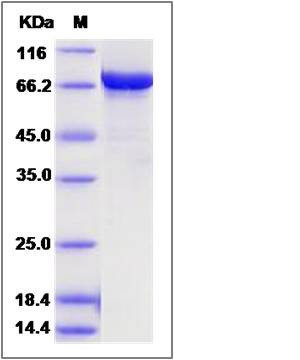Mouse Prolyl endopeptidase / PREP Protein (His Tag)
AI047692,AI450383,D10Wsu136e,PEP,Pop
- 100ug (NPP2778) Please inquiry
| Catalog Number | P50288-M07B |
|---|---|
| Organism Species | Mouse |
| Host | Baculovirus-Insect Cells |
| Synonyms | AI047692,AI450383,D10Wsu136e,PEP,Pop |
| Molecular Weight | The recombinant mouse PREP consists of 727 amino acids and predicts a molecular mass of 82.9 KDa. It migrates as an approximately 79-83 KDa band in SDS-PAGE under reducing conditions. |
| predicted N | His |
| SDS-PAGE |  |
| Purity | > 95 % as determined by SDS-PAGE |
| Protein Construction | A DNA sequence encoding the mature form of mouse PREP (Q9QUR6) (Leu2-Gln710) was expressed, with a polyhistidine tag at the N-terminus. |
| Bio-activity | |
| Research Area | |
| Formulation | Lyophilized from sterile 20mM Tris, 500mM NaCl, pH 7.4, 10% glycerol, 3mM DTT 1. Normally 5 % - 8 % trehalose, mannitol and 0.01% Tween80 are added as protectants before lyophilization. Specific concentrations are included in the hardcopy of COA. |
| Background | Prolyl endopeptidase, also known as PREP, belongs to a distinct class of serine peptidases. It is a large cytosolic enzyme which was first described in the cytosol of rabbit brain as an oligopeptidase. Prolyl endopeptidase degrades the nonapeptide bradykinin at the Pro-Phe bond. It is involved in the maturation and degradation of peptide hormones and neuropeptides such as alpha-melanocyte-stimulating hormone, luteinizing hormone-releasing hormone (LH-RH), thyrotropin-releasing hormone, angiotensin, neurotensin, oxytocin, substance P and vasopressin. Prolyl endopeptidase's activity is confined to action on oligopeptides of less than 10 kD and it has an absolute requirement for the trans-configuration of the peptide bond preceding proline. It cleaves peptide bonds at the C-terminal side of proline residues. |
| Reference |
